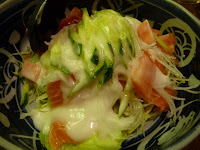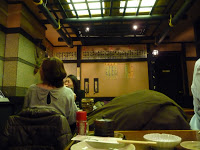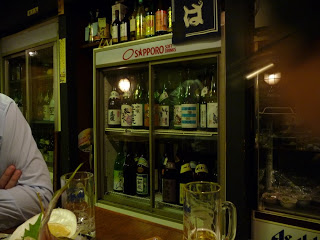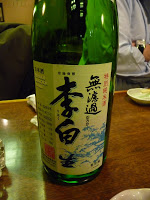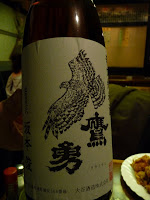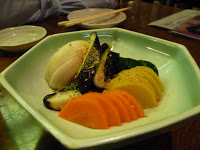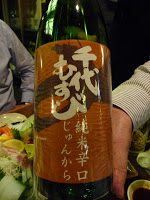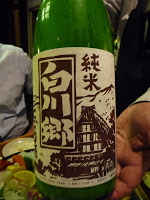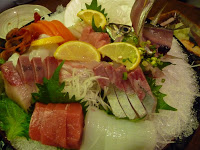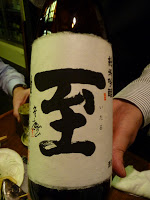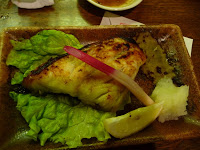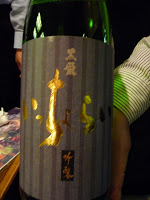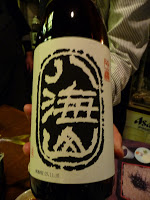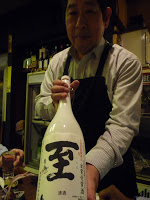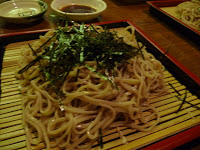With a name like this, and a web site featuring lots of pictures of gassho-zukuri houses (think Shirakawa-go, the huge thatched-roof farmhouses) you’d expect some kind of Hida theme. You’d be wrong. But if you went expecting some kind of sake theme, you’d be right – 100 varieties. Only a few weeks into the year and I’m already questioning my resolve to explore the world of sake more fully. It’s a harsh mistress.
[June 29, 2011: I am a bad, bad foreigner. I wanted to have a drink on my way home and was cruising around Ningyocho looking for a likely place. I went by here, saw the ‘jizake’ signs, got ready to go in, and finally realized that I’d been before…and didn’t like it. But I thought I’d give it a try, as I’ve learned an awful lot about sake in the 18 months since this review (it’s embarassing to read; I knew nothing).
The darkness, humidity, and smell were just like I remembered. Not a great start. The fridge didn’t look bad, but also not too interesting at this point in my sake evolution. I sat down. The master asked "Where’d ya come from?” This is a normal question, but when I’ve used it on Japanese people they usually laugh – it sounds more like "Where did you just come from,” not "What country are you from.” I paused, thinking if I should say "Otemachi” or "Mon-nake”. Eventually we got to business, and I asked the master for a summer sake.
I should explain, summer sake is a special lighter, zippier, more acidic sake that a lot of brewers release around now. It usually comes in a blue bottle, or a clear bottle with a blue label, or something to help you feel cooler in the heat. It’s been in bars for about 2 weeks. I asked what kind of summer sake he had.
He immediately went and got a bottle of Azakura, which is typically pretty strong and heavy. He poured a big glass for me. "Try it, try it,” he ordered. It was strong and heavy. "Is this really summer sake?” I asked. "There’s no such thing as summer sake,” he said. "Sake is made in January and February. You can’t make it now. waaa waaa wa waa waaaaaa…” I stopped listening.
After he walked away, I reflected on my unopened wet towel, my untouched glass of water, and the glass of sake I hadn’t ordered and didn’t want. I got up, walked to the door, ran up the stairs to the street, jumped on my bike, and hit the road.
I am a bad foreigner, because I didn’t thank the master for forcing something on me that I didn’t order and had no interest in. If you go to this place, I apologize, because he’ll hate foreigners even more from now on. I am a bad, bad foreigner.
Back to the original review. This place sucks worse than is implied below. It’s expensive too.]
Far back on the wall, those slips of paper represent the more normal parts of the sake selection…but only some parts of it.
This fridge represents rather more of it. Perhaps half? If you squint into the middle distance, you’ll see a second fridge, just as full as the first one. The menu book was indeed 10+ pages with 10 or so per page. They’re cutely organized by sumo ranks, which go up in quality and cost. Or rather, down, since they put the good stuff at the front of the book.
Well, no further ado, let’s drink. I’ve captured these for archival purposes.
Strictly archival purposes. This was very good though, Takaisami, ‘Courage of the Hawk’.
These pickles were just OK, which set a pattern for all the food.
Fortunately, there were ample archival materials.
[Chiyomusubi]
[Chiyomusubi]class="separator" style="clear: both; text-align: center;">